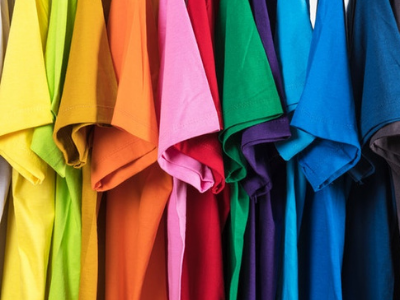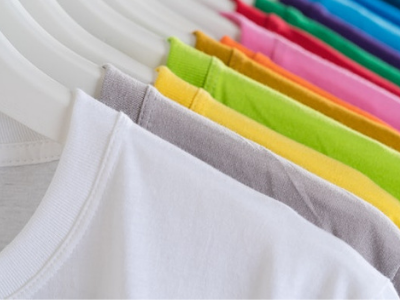Sublimation printing uses heat to fuse ink and fabric. Sublimation printing is becoming very popular, as it allows designers to print full-color images that will not crack and peel onto garments and other surfaces.
While this unique printing process certainly offers its fair share of advantages over other printing styles, sublimation printing will only work on certain types of fabric.
So, what are the best shirts for sublimation?
Generally, shirts made from polyester or a polyester blend are the best choice, and the higher the percentage of polyester, the better results you’ll get.
That said, it’s important to know what kind of fabrics to avoid, too.
What is the Sublimation Printing Process?

Before we explain which sublimation materials and blends offer the best results, let’s take a quick look at the basics of sublimation printing.
Sublimation printing starts by printing a digital design onto a specific type of paper called sublimation paper.
After placing the sublimation paper on top of the shirt in the desired location, a sublimation printing machine heats the shirt, and the sublimation transfer paper to the appropriate temperature, turning the ink into gas.
After the temperature cools, the ink returns to a solid, fusing it onto the shirt fabric.
Essentially, controlled heat and pressure combine to fuse gaseous ink to the surface of a fabric item, such as a shirt, hoodie, or flag.
Read our related article on How to Use Sublimation Paper. This beginner’s guide is a great place to start!
the Advantages of Sublimation Printing

When it comes to sublimation printing, the transferred design will be much more permanent than designs printed through other means.
Designs fused to clothing through sublimation printing are also much less prone to fading.
Since the printing process can occur quickly and allows for plenty of detail, it’s very popular with T-shirt businesses looking to create bold and colorful designs.
Another advantage of sublimation printing is that it allows you to print large designs on clothing. You can even print from seam to seam across the entire outer surface of a shirt.
This practice is so common that sublimation printing is sometimes referred to as ‘All Over Printing’ in the T-shirt printing industry. You can even use sublimation printing on mugs!
By choosing sublimation printing, you can print large, highly detailed designs that will not crack, peel, or fade.
That said, sublimation printing does have its downsides.
Read More: What is the Best Type of T-Shirt for Printing? We go over different materials and printing styles to help you choose!
The Problem with Sublimation Printing

Unfortunately, a sublimation printer only really works with specific types of fabrics. Essentially, any shirts you plan to print on must contain polyester or a similar synthetic fiber.
WARNING: Without these types of materials, the design will not adhere to the shirt properly, which will result in dull and faded designs.
Sublimation printing should also only be done on white fabrics, so any part of the shirt not exposed to the gaseous sublimation ink will stay white.
Keep in mind that accidental white spots can occur if the shirt is slightly folded or wrinkled during the sublimation process.
In simple terms, white shirts made from synthetic materials and blends will work well for sublimation printing, while natural materials, like 100% cotton, will not yield lasting results.
the Best Shirts for Sublimation Printing

Now that you know a little bit more about sublimation printing, let’s take a look at some of the best shirts for sublimation.
Read our related article on How to Choose Sublimation Paper for Dark Shirts. Sublimation printing on dark fabrics can be tricky. Here are our tips and tricks!
1. Shirts Made from Polyester Blends (Best to Use)
Shirts made from polyester and polyester blends are the best option for sublimation printing. Sublimation dye and ink will form the strongest bond with polyester molecules.
Not only does this mean that the printed polyester shirt will be less prone to fading, but it also means the design will turn out crisp and colorful.
It goes without saying that a 100% polyester shirt isn’t very practical.
The material would be uncomfortable and prone to peeling, especially after washing, which is why shirts made from a polyester blend are the top option for sublimation.
With that said, you’ll need a blend that contains a high percentage of polyester if you want the best results.
In general, we recommend polyester blends that contain at least 40% polyester fiber. However, a greater polyester concentration would allow for more detail and crisper colors.
Read More: What Does Sublimated Jersey Mean? Learn all about sublimation printing on jerseys!
2. Shirts Made from Nylon, Lycra, and Other Synthetic Materials
Shirts made from other synthetic blends will also work well for sublimation printing.
If the shirt contains a high volume of nylon, lycra, or spandex, the sublimation process will work, and the results should last.
Just make sure you’re using man-made material for your sublimation projects rather than a shirt made mostly of natural fibers, as these types of shirts often fade prematurely.
Read More: How Do You Do Sublimation On Dark Shirts? We walk you through the steps!
3. 100% Cotton Shirts (Least Durable Option)
It’s possible to use sublimation printing on a cotton shirt or garment, but you have to make sure that you use the right types of dyes. You may also need to apply a pre-treatment to the shirt to have the ink adhere to it properly.
With that said, a cotton-poly blend that contains a reasonably high percentage of the synthetic materials listed above will work.
Just remember that there’s a very high probability that the shirt will fade much faster than a blend with a high concentration of polyester or another synthetic material.
Some sublimation projects made from a cotton-polyester blend can yield reasonable results, but the colors will be somewhat faded. The sublimation ink will only attach itself to roughly half of the fibers that the shirt is made from.
Printing on a garment that’s a cotton blend means that you lose some of the color you would get by printing on a shirt that was made from a fabric with a higher polyester percentage.